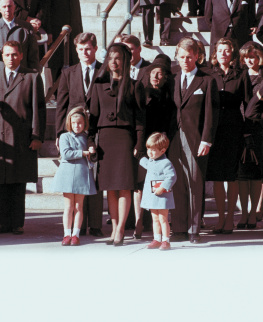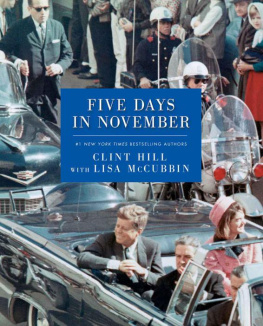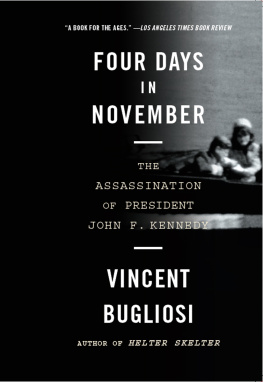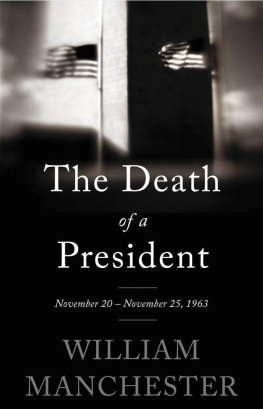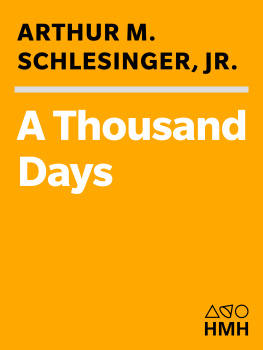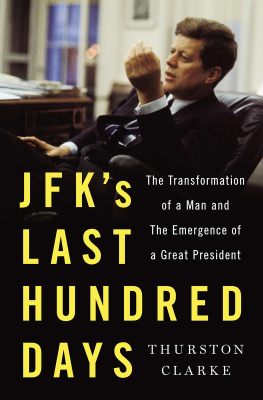Thank you for downloading this Gallery Books eBook.
Join our mailing list and get updates on new releases, deals, bonus content and other great books from Gallery Books and Simon & Schuster.
C LICK H ERE T O S IGN U P
or visit us online to sign up at
eBookNews.SimonandSchuster.com
Contents
In memory of
President
John Fitzgerald Kennedy
May 29, 1917November 22, 1963
Introduction
I t makes no difference how old you are, or what you have experienced, there are times in your life that affect you so deeply that, no matter what you do, no matter how hard you try to erase them, your mind will never let the memories fade. For me, there were five days in November 1963, when I was thirty-one years old, that are seared into my mind and soul. In the blink of an eye, everything changed, and in the fifty years since, those days remain the defining period of my life. As fate would have it, the photos snapped by journalists, witnesses, and bystanders during those five days are like the scrapbook that is in my mind. I was thrust onto the pages of history and have spent the majority of my life keeping silent about what I witnessed.
Recently, however, I have come to realize that the grief Ive held inside for half a century is shared by nearly everyone who was alive at that time, and that those days marked a defining period not just for me but for all of us. It has been a reluctant journey, but now, despite how painful it is, still, to relive those days, I understand that my memories are important to history.
President Kennedys election in 1960 coincided with the blossoming of a new era in American history. There was a marked difference between the outgoing leaderseventy-year-old President Dwight D. Eisenhower, a five-star general, a grandfatherly figureand the incoming forty-three-year-old President John F. Kennedy, with his quick wit and charismatic smile. In his eloquent and stirring inaugural address, President Kennedy stated, Let the word go forth from this time and place, to friend and foe alike, that the torch has been passed to a new generation of Americans...
His words rang true to those of us in that younger generation. We could see his vision. Financially, we were doing better than our parents had done, the economy was growing, and even for those who were struggling, there was hope and promise ahead.
This was also the beginning of the television agea time when Father Knows Best and Leave It to Beaver idealized the wholesome traditional families of the 1950s, while the nightly news brought images of civil rights clashes into peoples living rooms. The presidential debates between Kennedy and Nixon were the first ever shown on television, and the stark contrast between the younger, handsome Kennedys charming ease and Nixons apparent discomfort arguably tipped the election in Kennedys favor in the last critical weeks of the election.
President Kennedy recognized the power of television and its ability to connect him with the American people. He was the first president to conduct live televised press conferences without delay or editing, and people loved them. His quick-witted bantering with the press was so entertaining that college students and shift workers would rush home to tune in, while housewives scheduled their ironing in front of the television.
The American public was also enamored with the presidents beautiful young wife, Jacqueline, and their two children, Caroline and John. Clothing manufacturers produced copies of the first ladys classic suits and pillbox hats so the average American woman could dress in Jackie style, while the press clamored for photos and tidbits of information about the familys private activities. With their familys private plane, and homes in Hyannis Port and Palm Beach, the Kennedys lifestyle was one that most Americans could only dream about. People couldnt get enough of them. They were more popular than any television or movie stars; Jack and Jackie Kennedy were American royalty.
As the young American president and his elegant wife traveled outside the country, their popularity spread around the world. It was awe inspiring to see hundreds of thousands, and sometimes millions, of people in foreign countries standing along a motorcade route just to get a glimpse of this man whose vision for freedom, liberty, and peace resonated with people of all walks of life, of all different races and religions. As the first Catholic American president, Kennedy was held in especially high esteem by fellow Catholics, and his photograph hung prominently in living rooms, shops, and restaurants around the world.
During the Kennedy administration, I was an up-close-and-personal witness to what later would be called Camelot. On November 21, 1963, I accompanied President and Mrs. Kennedy to Texas as part of their Secret Service detail. As Special Agent in Charge of the First Ladys Detail, it was my responsibility to protect Jacqueline Kennedy, and I was with her constantly.
On November 22, when shots were fired during the motorcade in Dallas, there was a Secret Service agent who jumped on the back of the car, attempting to protect President and Mrs. Kennedy.
That was me.
Unbeknownst to me, an Associated Press photographer named James Altgens was on Elm Street in Dealey Plaza at the time of the assassination. He heard the shots, saw me run, and snapped a photo just as I climbed onto the back of the presidential limousine. That evening, and the next day, this photograph ran on the front pages of newspapers all over the world. From that point on, I would forever be known as the Secret Service agent who jumped on the back of the car. And while that photo has become one of several iconic images that were captured on film during those pivotal daysmoments of a national tragedy frozen in timenone of them standing alone tell the whole story.
On November 22, 1963, three shots were fired in Dallas, and the world stopped for four days. For an entire generation, it was the end of the age of innocence.
Clint Hill
DAY ONE

NOVEMBER 21, 1963
1
Leaving the White House
T he day we left for Texas begins like countless other presidential trips. People hustling through the halls to get last-minute changes to speeches typed; secretaries and press staff clamoring to be added to the manifest of authorized personnel; the presidential staff and assistants coordinating all the details for the president and the first lady. Everyone wants to make sure this trip goes without a hitch. Not only because this unofficial start to the 1964 campaign is critically important politically, but also because First Lady Jacqueline Kennedy will be accompanying her husband on the three-day swing through the Lone Star State. Mrs. Kennedy prefers to stay out of politics and, in the three years of the administration thus far, never before has she traveled with the president on a domestic political trip. This is a first. As the Special Agent in Charge of Mrs. Kennedys Secret Service Detail, it is my job to make sure nothing happens to her.

